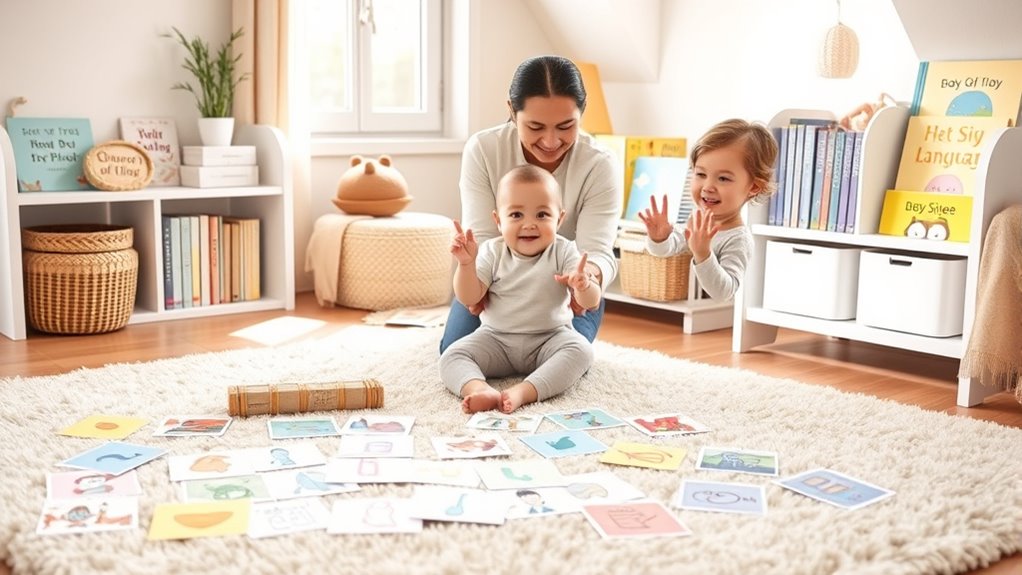Baby sign language is a fun way for you to communicate with your preverbal infant using simple gestures. Start around 4 to 6 months old, focusing on daily activities like “more,” “milk,” or “eat.” Use the FREE method: Fun, Repeat, Encourage, and Expand your practice during routines. Keep sessions short and engaging, and encourage your baby to mimic signs. With consistent practice, you’ll enhance your bond and support their cognitive development. There’s so much more to explore!
Key Takeaways
- Start introducing baby sign language around 4 to 6 months for early recognition and engagement.
- Focus on common signs like “more,” “milk,” and “eat” related to daily activities.
- Practice consistently by incorporating signs into your daily routines to reinforce learning.
- Use the FREE method: Fun, Repeat, Encourage, Expand to enhance the signing experience.
- Combine signs with spoken words to support overall language development and understanding.
What Is Baby Sign Language?

Baby sign language is a toolkit of simplified gestures that helps preverbal infants express their needs before they can talk. By teaching baby sign language, you enable your baby to communicate using simple signs that relate to daily activities. Typically, you can start teaching these signs around 6 to 7 months, with babies often using them by 8 to 9 months. Unlike American Sign Language (ASL), baby sign language focuses on basic communication without complex grammar.
Common signs include “more,” “milk,” “eat,” and “all done.” Using these signs can greatly reduce frustration for both you and your baby, allowing for clearer expression of needs and emotions long before verbal communication develops. Additionally, incorporating baby sign language can enhance parent-child bonding, fostering a deeper connection through shared communication experiences. This approach can also support clearer expression of emotions, making it easier for parents to understand their baby’s feelings and desires. Research has shown that omega-3 fatty acids can also play a role in brain development, potentially enhancing communication skills as your child grows.
Benefits of Baby Sign Language

Teaching your little one sign language offers a host of benefits that extend beyond simple communication.
You’ll enhance communication between parents and your baby, allowing them to express needs and emotions before developing verbal skills. This ability can lead to fewer tantrums and frustrations, as your little one can communicate using signs for hunger or discomfort. Additionally, extended separations can lead to emotional disconnection, highlighting the importance of consistent interaction during early development. Developing a growth mindset can also be beneficial as it encourages both parents and children to embrace learning and adaptability in this new communication method.
Research shows that babies who learn sign language often acquire verbal skills more quickly and may score higher on IQ tests later.
Additionally, engaging in baby sign language strengthens the parent-child bond, creating shared moments during early development. It also aids cognitive development by promoting memory and recognition, alongside supporting early literacy skills through visual learning, setting a solid foundation for future communication. Furthermore, emotional and psychological growth in children can be positively influenced by this form of interaction, enhancing their overall development.
How and When to Start Baby Sign Language

Starting baby sign language can be a rewarding experience, and it’s best to begin around 4 to 6 months of age. This early introduction helps your baby recognize and understand signs.
Here’s how to effectively start teaching:
- Choose common baby signs: Focus on signs related to daily activities like “more,” “milk,” and “all done.” Maximizing IRA Contributions through strategic planning can also enhance your financial literacy as your baby grows.
- Practice daily: Consistent daily practice is essential, as babies usually start signing back between 6 to 9 months. This regular practice can also support emotional expression through non-verbal communication.
- Use the FREE method: Make it Fun, Repeat often, Encourage your baby, and Expand on their learning.
- Incorporate signs: Combine sign language with verbal communication to enhance overall language development. Regular health checks for your baby’s development can also complement their learning process.
Common Baby Signs

Once you’ve begun introducing baby sign language, it’s time to focus on the specific signs that will make communication easier for both you and your little one.
Introducing baby sign language can significantly enhance communication between you and your little one.
Some common baby signs include “more,” where you pinch your fingertips together and tap them, helping your baby express their desire for additional food or play.
To indicate “milk,” open and close your hand like milking a cow.
For “all done,” start with your hands up and turn them outward, signaling that your baby has finished eating or playing.
To show they’re “hungry,” make a C-shaped hand and move it from their chest to their stomach.
Finally, for “sleep,” draw your hand down across their face while closing your fingers. Additionally, integrating essential communication tools like sign language can greatly enhance the bonding experience between you and your baby.
Tips for Teaching Baby Sign Language

As you commence on the journey of teaching your baby sign language, it’s important to begin around 6 to 7 months of age, when they’re most likely to start using signs by 8 to 9 months.
Here are some tips to help you effectively teach baby sign language:
- Use expressive gestures, facial expressions, and body movements during daily routines like feeding and changing.
- Focus on a few basic signs, such as “more,” “milk,” and “please,” and gradually introduce new signs as your baby learns.
- Incorporate fun activities like songs and games to make signing enjoyable and engaging.
- Guarantee consistent verbal communication accompanies signing to support both signing and speech development.
Resources for Learning Baby Sign Language

When you’re ready to start learning baby sign language, you’ll find plenty of resources at your fingertips.
From learning kits that include DVDs and flashcards to online communities offering support and advice, there’s something for everyone.
These tools can make your journey both engaging and effective, helping you connect with your little one in new ways.
Learning Materials Available
Numerous resources are available to help you learn baby sign language effectively. Here are some valuable learning materials to evaluate:
- Baby Sign Language Kits: These kits often include DVDs, guidebooks, dictionaries, flashcards, and wall charts, making it easier for you to engage with signing education.
- Online Resources: Websites and apps provide interactive learning experiences and teaching tools, including flashcards for daily practice.
- Workshops and Classes: Participating in hands-on environments allows you to learn alongside other parents, promoting shared experiences.
- Books: Numerous titles offer structured guidance, helping you navigate the teaching process with clarity.
With these materials, you’ll find it easier to introduce baby sign language to your little one!
Online Community Support
Finding support from online communities can make your journey into baby sign language much easier and more enjoyable. These platforms allow you to share experiences with other parents, discuss challenges, and celebrate progress.
You’ll find forums where you can ask questions and get advice from seasoned users and educators. Plus, many websites offer instructional videos and articles that provide step-by-step guidance on teaching signs effectively.
Virtual workshops enhance your understanding of baby sign language through interactive learning experiences. Additionally, you can access downloadable materials like flashcards and charts to reinforce learned signs and aid in vocabulary expansion.
Embracing these resources will boost your confidence and guarantee a richer signing experience for both you and your baby.
Frequently Asked Questions
What Is the Best Age to Start Baby Sign Language?
The best age to start baby sign language is between 4 to 6 months. At this stage, your baby can begin to recognize and understand signs.
By around 6 to 9 months, you might notice your little one starting to sign back. Consistent daily practice is key, so make it a fun routine!
What Signs Should I Teach My Baby First?
Start by teaching your baby essential signs that relate to daily needs. Focus on “more,” “milk,” “eat,” and “drink,” as these are frequently used during mealtime and playtime.
Make sure the signs you choose are visually distinct and easy for your baby to imitate. Once your baby masters these, gradually introduce signs for courtesy like “please” and “thank you” to help instill manners and enhance their communication skills over time.
What Are the 5 Basics of Sign Language?
The five basics of sign language include “more,” “milk,” “please,” “done,” and “hungry.”
These signs correspond to everyday needs, making it easier for you and your baby to communicate. When you consistently use these signs during daily routines, it helps reinforce their meaning.
Incorporate expressive gestures and facial cues to enhance understanding. Remember, your baby will likely start signing back between 6 to 9 months, so practice and patience are essential!
Is 12 Months Too Late to Start Baby Sign Language?
It’s never too late to open the door to communication!
At 12 months, you’re just beginning an exciting journey with your child. They can still learn and benefit from baby sign language, enhancing their ability to express needs and emotions.
Research shows that kids can grasp new signs up to age two, so introducing signs now can greatly reduce frustration for both of you.
Stay consistent, and watch your child’s communication skills blossom!
Conclusion
Incorporating baby sign language into your routine can be a fun and rewarding experience for both you and your little one. Did you know that studies show babies who use sign language can often communicate their needs up to six months earlier than those who don’t? By starting early and practicing regularly, you’ll strengthen your bond while helping your baby express themselves. So go ahead, start signing, and watch your child’s confidence grow!









